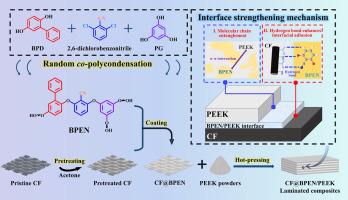通过添加联苯支化聚芳醚腈改善碳纤维/PEEK复合材料的界面相容性
IF 14.3
1区 材料科学
Q1 MATERIALS SCIENCE, MULTIDISCIPLINARY
引用次数: 0
摘要
碳纤维与PEEK基体之间的界面粘附不足是影响CF/PEEK复合材料力学性能和热学性能的主要障碍。本研究提出了一种分支度可控的含联苯支化聚(芳醚腈)(BPEN)作为界面相容剂,随后通过粉末浸渍辅助热压方法与PEEK一起加工,制备CF@BPEN/PEEK层压复合材料。当BPEN支化度为10%时,CF@BPEN/PEEK复合材料的层间剪切强度为39.7 MPa,弯曲强度为506.5 MPa,比原始CF/PEEK复合材料(23.9 MPa和363.9 MPa)分别提高了66.1%和39.2%。此外,改性层压复合材料的导热性(1.45 W m⁻¹K⁻¹)增强,玻璃化转变温度提高了约4°C, x波段电磁干扰屏蔽效果达到41.0 dB。这些多功能增强来自于一个强大的扩散驱动的界面,通过BPEN联苯单元和PEEK链之间的π -π堆叠相互作用,以及纤维表面氰基和含氧位点之间的氢键来构建。此外,由强极性BPEN结构引起的极化有助于有效的电磁干扰性能。本文章由计算机程序翻译,如有差异,请以英文原文为准。

Improved interfacial compatibility of carbon fibers/PEEK laminated composites via incorporating biphenyl-branched poly(aryl-ether-nitrile)
The insufficient interfacial adhesion between carbon fibers and the PEEK matrix remains a key obstacle to realizing the full mechanical and thermal performance of CF/PEEK composites. This work proposes a biphenyl-containing branched poly(aryl-ether-nitrile) (BPEN) with controlled branching degree as an interfacial compatibilizer and subsequently processed with PEEK via a powder-impregnation assisted hot-pressing method to fabricate CF@BPEN/PEEK laminated composites. When the BPEN branching degree is 10 %, the CF@BPEN/PEEK laminated composites exhibit interlaminar shear strength of 39.7 MPa and a flexural strength of 506.5 MPa, which are 66.1 % and 39.2 % higher than pristine CF/PEEK laminated composites (23.9 and 363.9 MPa), respectively. In addition, the modified laminated composites show enhanced thermal conductivity (1.45 W m⁻¹ K⁻¹), an elevated glass transition temperature by approximately 4 °C, and a remarkable X-band electromagnetic interference shielding effectiveness of 41.0 dB. These multifunctional enhancements originate from a robust, diffusion-driven interphase, constructed through π–π stacking interactions between BPEN biphenyl units and PEEK chains, as well as hydrogen bonding between cyano groups and oxygen-containing sites on the fiber surface. Furthermore, the polarization induced by the strong polar BPEN structure contributes to effective EMI performance.
求助全文
通过发布文献求助,成功后即可免费获取论文全文。
去求助
来源期刊

Journal of Materials Science & Technology
工程技术-材料科学:综合
CiteScore
20.00
自引率
11.00%
发文量
995
审稿时长
13 days
期刊介绍:
Journal of Materials Science & Technology strives to promote global collaboration in the field of materials science and technology. It primarily publishes original research papers, invited review articles, letters, research notes, and summaries of scientific achievements. The journal covers a wide range of materials science and technology topics, including metallic materials, inorganic nonmetallic materials, and composite materials.
 求助内容:
求助内容: 应助结果提醒方式:
应助结果提醒方式:


